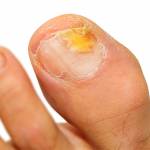Fungal Foot Infections
Fungal infections of both the skin and nails of the feet are caused by microscopic organisms only in this case, they are fungi, and like their counterparts, bacteria and viruses, are invisible to the naked eye. They exist everywhere, in the atmosphere and many of our general day to day surroundings. They flourish most in dark, moist, warm environments, attacking human skin and nails, particularly at times of mild debility or when the skin is damaged and therefore more susceptible to invasion. They are common conditions affecting approximately 10-15% of the population and are commonest in males.
Signs and Symptoms
The most typical fungal infection of the skin is known as Athletes Foot or by its medical name tinea pedis. Its name is a reference to the ‘plimsolls’ or ‘pumps’ footwear worn by athletes which provided the perfect environment for the growth of the fungi involved. Athlete’s foot most commonly affects the skin between the toes or on the bottom of the feet, it causes peeling, redness, itching and sometimes a burning sensations as well as blisters.
The infection can spread to your toenails. Infection of the nails is called onychomycosis and is quite often a complication of what was originally an untreated, or inadequately treated skin infection such as Athlete’s Foot. The nails appear thickened and discoloured and frequently have a crumbly texture. However, not all nail symptoms like this are due to fungal infection. There are many other conditions which cause a similar appearance, such as poor circulation to the nail bed, psoriasis of the nails etc.
Diagnosis is confirmed by a simple laboratory test which can ascertain for certain whether the problem is a fungal one, or if there is another cause.
Where Do We Catch Them From?
These fungi are very contagious and the most common sources of infection are communal showers and bathing facilities in leisure centres and swimming pools, though they can also be contracted by barefoot activity on dry floors such as those found in gymnasia. Unfortunately the disinfectant baths frequently found at the entry point to swimming pools are often useless because the fungus lives in tiny pieces of skin debris which are waterproof.
Prevention
It is frequently said that prevention is better than cure and this is very true. Here are some tips to help you avoid these fungal infections. The first and obvious one is good daily foot hygiene. The feet should be washed in warm soapy water, then rinsed before drying carefully, paying particular attention to the skin between and beneath the toes. Dusting afterwards with a medicated talc containing a mild anti-fungal agent is beneficial and ensures that you do not cause resistance to the stronger agents which may be needed for an infection at a later date.
If your toes are very tight together, this reduces the natural air-flow between them and makes the skin more vulnerable. The use of a little surgical spirit between the toes at bedtime, can work wonders. A cotton bud is a useful applicator. Leave the spirit to vaporise after the application and this will act as
an astringent to the skin and at the same time help to remove any residual moisture from the day’s activities.
Footwear should be composed of natural materials as far as possible as these allow the feet to “breathe”. Socks of wool or cotton and shoes of real leather are advised for people who are prone to this problem. Whilst it is almost impossible to obtain such things as silk stockings in this day and age, ladies should allow a period of time during regular parts of the day when they can dispense with nylon hosiery and allow air to the feet, for at least half an hour at a time. Never wear anyone else’s footwear.
Why Should We Treat This Problem?
Firstly, none of us take kindly to pain and discomfort. Secondly, the condition does not usually resolve without treatment. Thirdly, once infected we can pass the fungus on to someone else, often within the family. Finally, the results of these infections, particularly the nails, can become disfiguring and if left untreated over a period of time, can cause permanent destruction of the nail plate.
Treatment
Should you suffer the misfortune of contracting a fungal infection, keep a towel and shower / bath mat solely for your use. Avoid standing barefoot on the bathroom floor and seek the advice of your chiropodist regarding the disinfection of shoes, which can remain a source of infection if not dealt with.
Usually, skin infections of this type respond very well to anti-fungal preparations which take the form of creams, ointments, paints and powders. These are called topical medications, ie they are applied to the skin and are not taken internally. Your chiropodist will be able to recommend a suitable preparation for your problem.
In the past, attempts were made to eliminate the fungal infections in nails in this manner, but because of the difficulties associated with achieving penetration of tissue as hard as nail, success rates were poor.
The good news is that modern pharmacy has developed some tablets that can be taken orally which eliminate the fungus from within the body (systemically). Those most recently developed are very efficient indeed and whilst fairly expensive initially, are cost effective in that they eliminate the need for protracted periods of treatment. Whilst present regulations prevent your chiropodist from prescribing them for you, he or she will be able to refer you to your family doctor who is able to issue a prescription.

